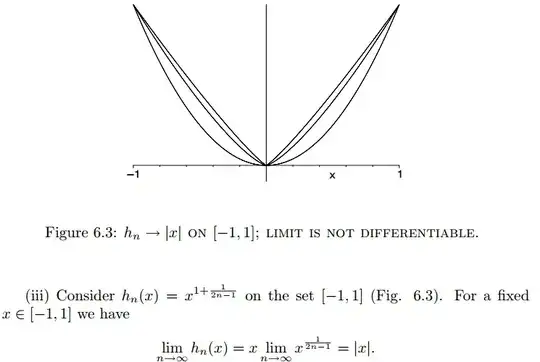Take $h_n(x) = x^{1+ \frac{1}{2n-1}}$ on the set $[-1,1]$
Then if we take $\lim_{n \to \infty} h_n(x)$ shouldn't this converge to $x$
seeing as
$$\lim_{n \to \infty} h_n(x) = x \lim_{n \to \infty} x^{\frac{1}{2n-1}} = x?$$

Take $h_n(x) = x^{1+ \frac{1}{2n-1}}$ on the set $[-1,1]$
Then if we take $\lim_{n \to \infty} h_n(x)$ shouldn't this converge to $x$
seeing as
$$\lim_{n \to \infty} h_n(x) = x \lim_{n \to \infty} x^{\frac{1}{2n-1}} = x?$$

Here are the steps $$ \lim\limits_{n\to\infty}x^{1+ \frac{1}{2n-1}}= \lim\limits_{n\to\infty}x^{\frac{2n-1+1}{2n-1}}= \lim\limits_{n\to\infty}x^{\frac{2n}{2n-1}}$$ $$= \lim\limits_{n\to\infty}\left(x^2\right)^{\frac{n}{2n-1}}= \left(x^2\right)^{ \lim\limits_{n\to\infty} \frac{n}{2n-1}} $$ $$= \left(x^2\right)^{ \lim\limits_{n\to\infty} \frac{1}{2-\frac1n}}= \left(x^2\right)^{\frac{1}{2-0}} = \left(x^2\right)^{\frac{1}{2}} $$ $$= \sqrt{x^2}=|x|$$
Because $x^{1+\frac{1}{2n-1}}=x^{\frac{2n-1+1}{2n-1}}=(x^2)^{\frac{n}{2n-1}}$ you will have the positive numbers $x^2$ with Exponent $e_n := \frac{n}{2n-1}$. When you compute $\lim_{n \rightarrow \infty} e_n = \lim_{n \rightarrow \infty} \frac{1}{2-\frac{1}{n}} = \frac{1}{2}$ you will get for the Limit $(x^2)^{\frac{1}{2}}$, a square root of These positive numbers. Clearly: $\sqrt{x^2}=|x|$.
With all due respect, this answer is to argue that the OP is right and the example in a book gets the limit wrong.
Let's $-1<x<0$ to focus on the negative numbers only.
The illustration of the curves $h_n(x)$ for several values of $n$ suggests that the author's argument is something similar to:
since $\forall n\in\mathbb{N}$ an odd root of a negative number $x$ is negative:
\begin{align} \sqrt[2n-1]{x}&=-\sqrt[2n-1]{|x|}, \end{align} then \begin{align} x\cdot (\sqrt[2n-1]{x})=-x\cdot(\sqrt[2n-1]{|x|})=|x|\cdot(\sqrt[2n-1]{|x|}). \end{align}
And then a limit is taken:
\begin{align} \lim_{n \to \infty}|x|\cdot(\sqrt[2n-1]{|x|})=|x|. \end{align}
And indeed, an illustration clearly shows that the curve is closer and closer to $|x|$ with bigger $n$, but can you spot a false step here?
What is missed here is that the limit of a sequence is something different from the sequence elements, which can sometimes have some properties that none of the items $h_n$ has.
The very basic assumption "the root is odd" is valid for any arbitrary big $n$, but it is not true when $n=\infty$. In other words, the $-1$ can "ecsape" any gravity of the odd root, except the infinite one.
The original limit is simple, if we just look at the power:
\begin{align} 1+\lim_{n \to \infty}{\frac{1}{2n-1}}=1, \end{align} and $x^1=x$, period.
What the book (and the other two answers) suggests is that that limit is somehow something different from the number $1$, which is absurd, similar to that kind of "proofs" like $-1=1$.